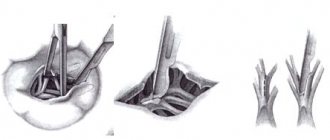Barlow's disease, or mitral valve prolapse, is a disease associated with dysfunction of the valve, which is located between the ventricle and the left atrium. Its essence is that blood returns back from the heart to the ventricle.
Previously, it was believed that the disease develops only in children and adolescents. However, modern research has found that people of all ages are susceptible to it.
Prolapse can be minor, so that the patient does not even feel discomfort. In this case, treatment is not prescribed.
How to recognize prolapse?
Since in the first and second degrees the disease can occur without symptoms, you need to contact a good cardiologist in Rostov (Western) to diagnose it. A doctor can determine congenital prolapse by a number of external signs, including: above average height and elongated limbs, as well as hypermobile joints.
When visiting a cardiologist, the patient can list the following complaints, after which the doctor will prescribe an ultrasound scan:
- Frequent dizziness and faintness;
- The appearance of shortness of breath;
- Arrhythmia and interruptions in cardiac function;
- Fatigue and panic attacks;
- Chest pain.
In this case, the cardiologist will write a referral and tell you how much an ultrasound will cost to make a diagnosis. You will also need to do an x-ray and an ECG. Daily monitoring of cardiac activity and bicycle ergometry are prescribed.
The reason for clarifying the cost of ultrasound will also be noises that the doctor may detect at the appointment. To establish their cause, you will also need to do ultrasound diagnostics.
Mitral valve prolapse
Mitral valve prolapse
is a problem that is accompanied by dysfunction of the heart valve located between the left atrium and left ventricle.
When the atrium contracts, the valve opens and blood flows into the ventricle, the valve closes and blood exits into the aorta.
With pathology of connective tissue or changes in the heart muscle, the structure of the valve changes, its leaflets “bend”, as a result, part of the blood is directed back into the atrium.
Symptoms of severe mitral valve prolapse are:
- pain in the heart area,
- fainting,
- interruptions in heart function,
- dizziness,
- dyspnea.
The reasons for the appearance of this pathology are not completely clear. But it is clear that they can be congenital genetic disorders, or they can appear under the influence of a number of reasons.
Acquired causes of mitral valve prolapse can be:
- cardiac ischemia,
- myocarditis,
- myocardial infarction,
- cardiomyopathy,
- calcium deposits on the mitral annulus.
It is clear that severe mitral valve prolapse can be dangerous. But most people with this disease generally live normally for many years, the dysfunction of the valve occurs slowly, symptoms appear only when the degree of prolapse reaches a certain value, that is, the valve flaps bend greatly. This occurs with the second and third degrees of prolapse.
Problems in this case include rupture of the cardiac chords, infective endocarditis, myxomatous changes in the valve leaflets, heart failure, and even sudden death. Fortunately, the latter is very rare with mitral valve prolapse.
Degrees of the disease
- degree - the valve flaps bend by 3-6 mm.
- degree – bend by 9 mm maximum.
- degree – bend by more than 9 mm.
Treatment of the disease
Treatment is prescribed by a cardiologist and only if the prolapse is accompanied by heart rhythm disturbances and pain in the heart.
In addition to special drugs, tranquilizers are usually used. The patient is often taught auto-training and muscle relaxation.
It is often necessary to change your lifestyle to avoid overwork and excessive stress.
Moderate physical activity is recommended, sometimes special breathing exercises; mandatory rest is desirable, preferably at resorts, water procedures, and spinal massage.
It is recommended to stop smoking, drink strong tea and coffee, and avoid alcohol.
Special drugs are usually prescribed for diseases of degrees 2 and 3
. But the pills cannot affect the valve itself: they only relieve symptoms.
Usually these are drugs to improve metabolism (Carnitine, Vitalain, Tison and others), infusions of valerian and motherwort. For arrhythmia, beta blockers are prescribed.
Surgery is usually used in difficult cases, such as rupture of the mitral valve leaflets. In this case, the valve ring is strengthened or a new valve is inserted.
Prevention of the disease mainly consists of working to reduce the risk of developing stages 2 and 3 of the disease.
It is necessary to regularly visit a cardiologist, follow a rest and nutrition regimen, and exercise.
It should be noted that the disease is usually congenital and sometimes the need for its treatment in children naturally arises.
Differentiated approach in the treatment of aortic valve insufficiency
Aortic valve replacement through an incision in the aortic wall
Diagnosed asymptomatic mild aortic insufficiency does not require specialized treatment, however, limiting physical activity and annual visits to a cardiologist are strongly recommended. The indication for conservative therapy is moderate aortic insufficiency in the absence of symptoms; in this case, it is worth visiting a cardiologist at least once every six months.
In case of severe aortic valve insufficiency and the absence of symptoms of insufficiency, constant drug therapy, examination by a cardiologist every six months, and echocardiography once or twice a year are prescribed. Indications for surgical treatment are severe aortic insufficiency in the presence of clinical symptoms and the development of left ventricular heart failure.
Finally, it is important to remember that the success of recovery most often depends on your emotional state.
General understanding of heart valve defects
Aortic valve stenosis
Heart valve defects are congenital or acquired defects of the valve apparatus, leading to its dysfunction. Acquired defects are much more common, and the left half of the heart is mainly affected, so defects such as tricuspid valve stenosis are quite rare. Changes in the structure of the valves or underlying structures that regulate their function lead to hemodynamic disturbances.
Acquired heart valve defects predispose to the development of the disease - infective endocarditis, arrhythmias and conduction disturbances and, ultimately, to heart failure. Heart valve defects can be divided into two groups: insufficiency and stenosis.
Valve insufficiency is a condition in which the valves do not sit close together when they close, causing blood to flow backwards.
Stenosis is a condition in which there is a narrowing of the opening blocked by the valve, which entails a decrease in the incoming blood volume.
Cases where insufficiency and stenosis affect one valve are usually called the development of a combined defect. When two or more valves are affected - combined.
About technology
This technology is the implantation of an aortic valve using a small (or no) incision on the thigh, which means without opening the chest and without cardiac surgery!
Through a puncture (or small incision) in the artery, an artificial valve is inserted in a compressed state, which expands when it is installed in place of the damaged aortic valve. After opening, the valve begins to function and restores the full and normal functioning of the aorta.
For the first time in Russia, the private multidisciplinary clinic “Center for Endosurgery and Lithotripsy,” relying only on its own resources and without spending budgetary funds on healthcare, performed this unique and high-tech operation on two patients aged 74 and 82 years.
Moreover, in one of the patients, multiple atherosclerotic lesions of the heart vessels were previously eliminated using a “non-surgical” method without anesthesia. Thus, the patient’s complex lesion of the heart vessels and aortic valve was completely cured using two high-tech minimally invasive techniques without cardiac surgery requiring anesthesia, opening the chest and artificial circulation.
1.What happens during normal surgery?
If surgery is required to treat heart valve disease, it can be performed traditionally, minimally invasively, or minimally invasive balloon valvuloplasty.
Traditional surgery to treat heart valve disease is performed under general anesthesia. The surgeon makes an incision in the center of the chest, thereby allowing direct access to the heart (in this case, actually open heart surgery is performed). The surgeon then operates on the abnormal valve, eliminating its defects, or replaces the heart valve.
A must read! Help with treatment and hospitalization!
Valve insufficiency clinic
Fatigue and shortness of breath
In the initial stages of the disease, patients may not complain at all. This period is called the compensation stage. In the future, patient complaints depend on the severity of the disease and whether the valvular heart disease is isolated or combined. When complaints appear, the stage of decompensation of the process begins, which over time can lead to heart failure.
With moderate mitral regurgitation, the patient is concerned about fatigue and shortness of breath. In more serious cases, scanty hemoptysis may occur due to pulmonary edema. Due to the progressive enlargement of the left atrium, compression of the nerve innervating the larynx occurs, which is clinically manifested by hoarseness of the voice.
With aortic valve insufficiency, the initial symptoms are shortness of breath, rapid heartbeat and chest pain. Arterial hypotension and pulmonary edema can occur with severe aortic insufficiency. In the absence of timely surgical intervention, there is a high risk of death.
Treatment methods
The main method of solving the problem today is prosthetics. For mild or moderate valve insufficiency, drug therapy is not prescribed; inhibitors are prescribed for severe disease that does not produce specific symptoms.
Two types of surgical intervention are used: valve replacement and plastic surgery. If the structure of the valve is preserved, there are no changes in the tissues and its mobility is completely preserved, patients undergo plastic surgery. Changed and thickened tissues require a different approach - prosthetics.
Plastic surgery has an advantage over prosthetics - fewer postoperative complications and a reduced risk of infective endocarditis.
Mild aortic insufficiency, which has an asymptomatic course, does not require therapy, however, patients are limited in physical activity and hard work is contraindicated for them.
Every year it is necessary to undergo examination by a cardiologist. When symptoms appear, patients are prescribed drug therapy.
Severe valve insufficiency requires constant conservative treatment; surgical intervention may be performed if indicated.
Valve disease in rheumatism
Chronic inflammation of the nasopharynx in children can lead to rheumatism. The disorder is caused by persistent infection with streptococci. Rheumatic prolapse is difficult to diagnose, as there are no special laboratory tests.
In order to identify the problem, doctors use a list of symptoms, analyze patient complaints and take into account the clinical manifestations of the disorder.
If the mitral and aortic valves are damaged, patients are treated in the hospital with antibiotics and anti-inflammatory drugs.











